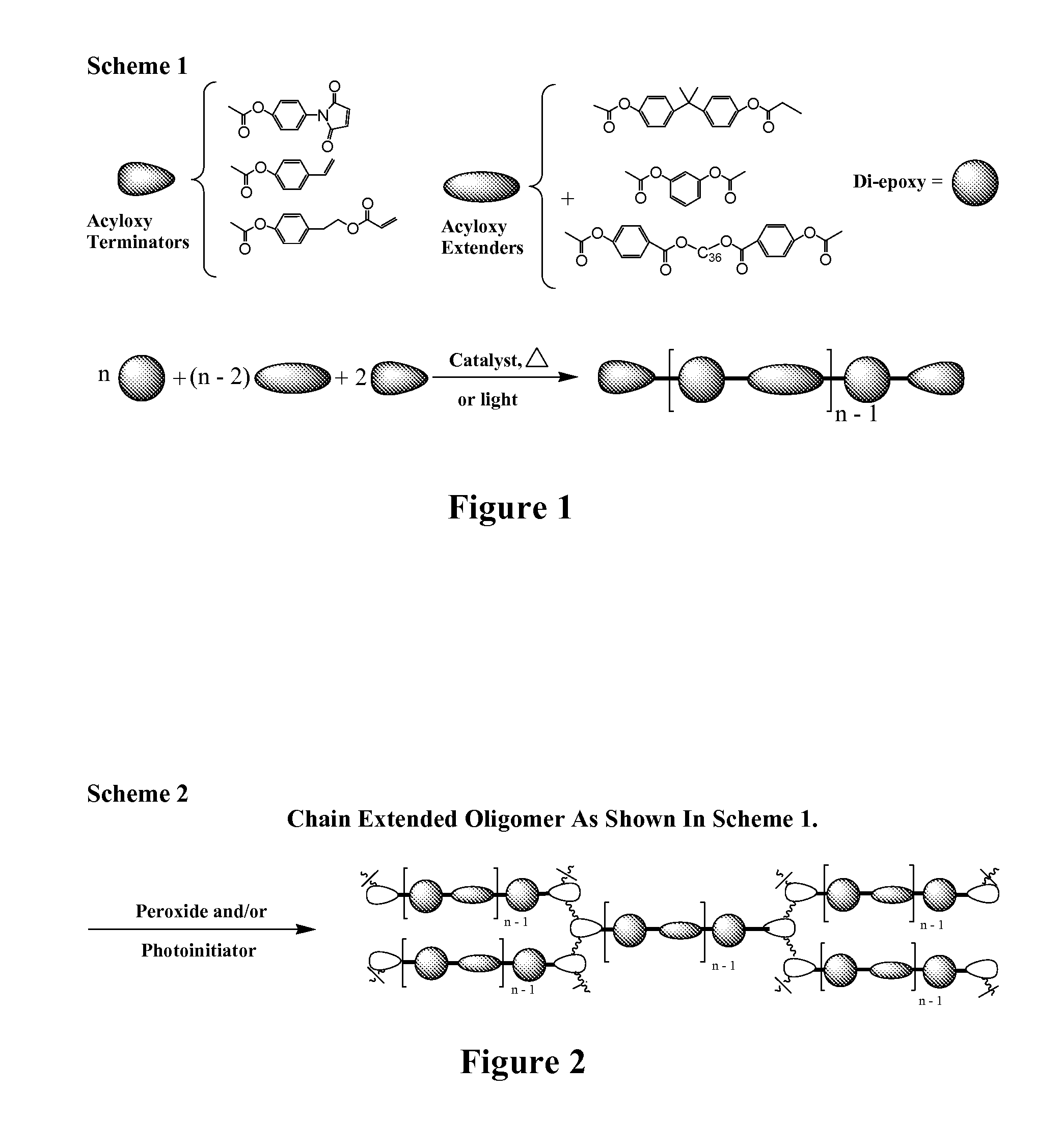Curatives for epoxy adhesive compositions
a technology of compositions and cure agents, applied in the field of thermosetting compositions, can solve the problems of certain drawbacks of cure agents, and achieve the effects of reducing weight loss, increasing adhesion, and decreasing viscosity
- Summary
- Abstract
- Description
- Claims
- Application Information
AI Technical Summary
Benefits of technology
Problems solved by technology
Method used
Image
Examples
example 1
Preparation of a Phenol Functional Curative
[0089]
[0090]A 500 mL, 2-neck flask was charged with 44.27 g (0.2 mole) 3-aminopropyltriethoxysilane, and 20.79 g (0.21 mole) butyl-4-hydroxybenzoate. The flask was equipped with a Dean-Stark trap condenser and bubbler. The mix was then stirred magnetically and heated at 170° C. under an argon blanket for 41.25 hours. Approximately 18.0 mL of butanol was collected in the trap (theoretical yield=18.3 mL). The mix was sparged with argon at 170° C. for forty-five minutes. The product was poured out of the container while still hot. It was a very viscous amber liquid at room temperature. A total of 65.6 g of product was recovered (96.0% of theoretical yield). An FTIR run on this compound had a broad —OH absorbance as well as strong absorptions at 2930, 1688, 1605, 1531, 1270, 1162, 1073, 953, 848, and 769 wavenumbers.
example 2
Preparation of a Phenyl Acetate Curative
[0091]
[0092]A portion of the compound from EXAMPLE 1 was converted to the phenyl acetate shown above. A 250 mL flask was charged with 37.15 g (0.11 mole) of the compound from EXAMPLE 1, 11.02 g (0.11 mole) acetic anhydride, and 0.1 g of dimethylaminopyridine. This mix was heated and stirred at 90° C. for two hours. The acetic acid side product was then removed via rotary evaporation and sparge. The final product weighted 40.5 g (97% of theoretical yield). An FTIR spectrum of this material revealed a small amide N—H stretch at 3318 along with prominent absorptions at 2934, 1760, 1639, 1501, 1268, 1198, 1073, 913, and 762 wavenumbers.
example 3
Comparison of Epoxy Formulations Containing Phenol Functional Curative to the Corresponding Phenyl Acetate
[0093]The following example demonstrates the remarkably improved adhesion for an epoxy resin cured using an acyloxy coupling agent from EXAMPLE 2, versus the analogous phenol-functional coupling agent from EXAMPLE 1, which does not contain the acyloxy moiety.
TABLE 1Properties of Expoxy Formulations Containing a Phenol FunctionalCurative and Corresponding Phenyl AcetateFormulation 1Formulation 2CompositionTactix 756 epoxy31.6%31.6%Ricon15.2%15.2%Terpineol36.7%36.7%Curezol 2MA1.1%1.1%Silica1.1%1.1%EXAMPLE 1 compound2.1%0.0EXAMPLE 2 compound0.02.1%Adhesion*(300 × 300 Si on ceramic @11.131.5260° C. 175° C.60 min ramp cure + 4 hourPMC) units are kg force.*The die-shear adhesion was measured as kg force on a Dage Series 4000.
[0094]The phenyl acetate functional coupling agent had almost three times the 260° C. adhesion of its phenol functional counterpart. Even at a relatively low perc...
PUM
| Property | Measurement | Unit |
|---|---|---|
| temperatures | aaaaa | aaaaa |
| thixotropic slope | aaaaa | aaaaa |
| thixotropic slopes | aaaaa | aaaaa |
Abstract
Description
Claims
Application Information
 Login to View More
Login to View More - R&D
- Intellectual Property
- Life Sciences
- Materials
- Tech Scout
- Unparalleled Data Quality
- Higher Quality Content
- 60% Fewer Hallucinations
Browse by: Latest US Patents, China's latest patents, Technical Efficacy Thesaurus, Application Domain, Technology Topic, Popular Technical Reports.
© 2025 PatSnap. All rights reserved.Legal|Privacy policy|Modern Slavery Act Transparency Statement|Sitemap|About US| Contact US: help@patsnap.com



